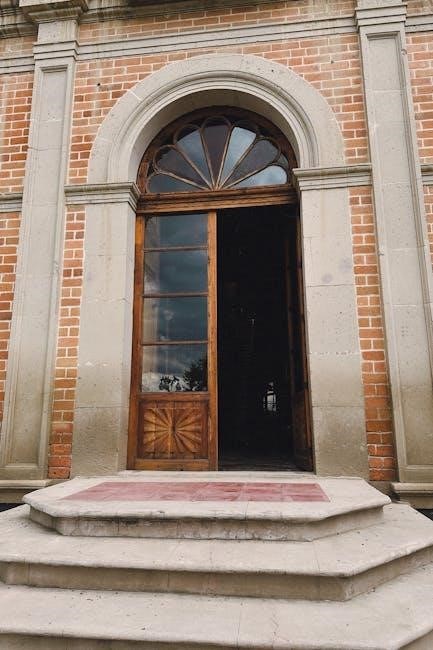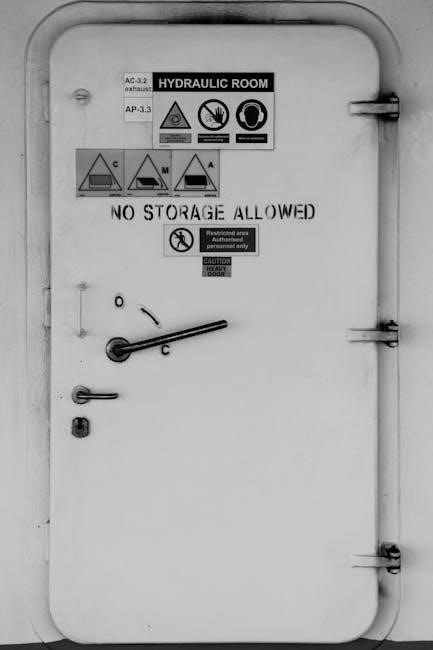The Template-Door-Modelbouw․pdf is a comprehensive guide for creating detailed door models, offering precise measurements and customizable designs․ It enhances model building projects with realistic and scalable templates for various applications․
1․1 Importance of Door Templates in Model Building
Door templates are essential for achieving precision and realism in model building projects․ They provide pre-designed patterns and measurements, enabling creators to craft intricate and accurate door designs․ These templates save time by offering ready-to-use layouts, ensuring consistency across projects․ Whether for architectural models, DIY crafts, or educational purposes, door templates enhance the authenticity of miniature structures․ They allow for customization, catering to various styles and scales, from Victorian to modern minimalist designs․ The Template-Door-Modelbouw․pdf stands out as a valuable resource, offering detailed technical drawings and dimensions․ Its versatility makes it a go-to tool for both professionals and hobbyists, ensuring that doors in models are proportionate and visually appealing․ By streamlining the design process, door templates empower creators to focus on other aspects of their projects, fostering creativity and efficiency․
1․2 Historical Development of Model Building Templates
The concept of model building templates has evolved significantly over time, transitioning from basic hand-drawn designs to highly detailed digital formats․ Historically, modelers relied on manual drafting techniques to create door templates, which were often time-consuming and prone to errors․ The advent of CAD software revolutionized this process, enabling the creation of precise and scalable templates․ The Template-Door-Modelbouw․pdf represents this modern approach, offering a comprehensive and user-friendly resource for model builders․ Its development reflects the growing demand for accuracy and customization in miniature designs․ Over the years, the internet has played a pivotal role in making these templates accessible, with platforms like Freecads and Grim Guys Software providing free downloadable resources․ This historical progression highlights how templates have become indispensable tools for architects, students, and hobbyists alike, bridging the gap between traditional craftsmanship and contemporary design practices․

1․3 Key Features of the Template-Door-Modelbouw․pdf
The Template-Door-Modelbouw․pdf is a versatile resource designed for model building enthusiasts, offering detailed door templates with precise measurements and customizable designs․ It includes a wide range of door styles, from classic Victorian to modern minimalist options, ensuring versatility for various projects․ The template provides technical drawings with top, front, and side views, enabling users to achieve accuracy and realism in their models․ Its CAD-compatible format makes it ideal for professionals and students working in AutoCAD․ Additionally, the PDF is user-friendly, allowing DIY enthusiasts and hobbyists to print, cut, and assemble doors effortlessly․ The template’s structured layout ensures that users can easily edit and adapt designs to suit their specific needs․ This resource is particularly valuable for architectural model making, educational purposes, and small-scale DIY projects, making it a must-have for anyone looking to enhance their model building skills with realistic and detailed door designs․
Door Design Options
The Template-Door-Modelbouw․pdf offers a wide range of door styles, including single, double, and sliding options, with customizable designs to suit various architectural and creative projects, ensuring versatility and realism;
2․1 Types of Doors Included in the Template
The Template-Door-Modelbouw․pdf includes a variety of door designs to cater to different project needs․ It features single doors, double doors, and sliding doors, each with detailed measurements and styles․ The template also offers classic Victorian, modern minimalist, and other architectural designs, ensuring versatility for model buildings․ Whether you’re creating a historical mansion or a contemporary home, the range of options allows for precise replication of real-world doors․ Additionally, the templates are scalable, making them suitable for both small-scale and large-scale models․ The diverse selection ensures that users can choose the perfect door style to match their project’s aesthetic and functional requirements․ This extensive collection makes the template a valuable resource for architects, hobbyists, and students alike․

2․2 Customization Possibilities for Different Models
The Template-Door-Modelbouw․pdf offers extensive customization options, allowing users to tailor doors to fit specific model building projects․ With editable images, texts, and colors, the templates can be personalized to match various architectural styles․ The detailed dimensions and design elements enable precise adjustments, ensuring doors align perfectly with the scale and theme of the model․ Whether creating a Victorian-style mansion or a modern minimalist structure, the template’s adaptability allows for unique modifications․ DIY enthusiasts and professionals alike can benefit from the easy-to-follow instructions, making it simple to adapt the templates for different models․ The inclusion of CAD drawings and downloadable PDFs further enhances customization, providing a flexible resource for both educational and professional applications․ This versatility ensures the template meets the diverse needs of modelers, from intricate historical designs to contemporary creations․
2․3 Popular Styles and Designs Available
The Template-Door-Modelbouw․pdf features a diverse range of popular door styles, catering to various architectural preferences․ From classic Victorian designs to modern minimalist aesthetics, the templates provide detailed blueprints for crafting authentic miniature doors․ The collection includes single, double, and sliding door models, each with precise measurements and design elements․ Users can explore traditional, rustic, and contemporary styles, ensuring compatibility with different model building projects․ The templates also incorporate historical and cultural influences, offering a versatile selection for both historical and modern constructions․ With downloadable PDFs and CAD drawings, modelers can easily access and implement these designs․ The variety of styles ensures that doors can be tailored to match specific periods or themes, making the template a valuable resource for achieving realistic and visually appealing models․ This extensive range makes it ideal for both novice and experienced model builders seeking authenticity and detail․
Technical Aspects

The Template-Door-Modelbouw․pdf provides precise technical details for creating accurate door models, including measurements, materials, and assembly instructions, ensuring realistic and professional results in model building projects․
3․1 Detailed Dimensions and Measurements
The Template-Door-Modelbouw․pdf includes precise measurements for door models, ensuring accuracy in scale and proportions․ It provides detailed dimensions for various door types, such as width, height, and thickness, along with frame and hinge placements․ The template also specifies material thickness for realistic representation․ Measurements are tailored for different scales, from 1:10 to 1:50, catering to diverse modeling needs․ Clear markings and labels guide users in cutting and assembling doors accurately․ This attention to detail minimizes errors and ensures models look authentic․ Additional notes on spacing and alignment help achieve professional finishes, making it ideal for both beginners and experienced modelers․ The template’s measurement system is adaptable, allowing users to scale dimensions for custom projects while maintaining realism and structural integrity․
3․2 Top, Front, and Side Views in CAD Drawings
The Template-Door-Modelbouw․pdf provides comprehensive CAD drawings with top, front, and side views of doors, offering a detailed visual representation․ These views are essential for understanding the door’s structure, alignment, and proportions․ The top view highlights the door’s width and frame dimensions, while the front view showcases the height, panel design, and hardware placement․ Side views reveal the door’s thickness and hinge details․ These drawings are scaled accurately, making it easy to visualize and replicate the design in models․ The template also includes annotations for precise measurements and alignment points, ensuring consistency․ These CAD views are particularly useful for architectural model making and hobbyist projects, as they provide a clear reference for scaling and customization․ By offering multiple perspectives, the template helps users achieve a high level of accuracy and realism in their door models․ This feature is invaluable for both beginners and experienced modelers․
3․3 Ensuring Accuracy and Realism in Models
Achieving accuracy and realism in model building is a cornerstone of the Template-Door-Modelbouw․pdf․ The template provides precise measurements and proportions to ensure doors align perfectly with their surroundings․ Detailed layering and texturing options allow for realistic depth, replicating the look of real-world materials like wood, metal, or glass․ The template also includes alignment guides to help position doors accurately within frames, preventing common errors․ For added realism, users can customize small details such as hinges, handles, and thresholds․ The template’s scalability ensures consistency across different model sizes, maintaining a professional finish․ By incorporating these features, modelers can create doors that appear lifelike and seamlessly integrate into larger designs․ This attention to detail makes the template indispensable for both hobbyists and professionals aiming for high-quality, realistic models․ The result is a door that looks authentic and enhances the overall aesthetic of the model․

Materials and Tools
High-quality materials like foam board, cardboard, or laser-cut wood ensure durability; Essential tools include craft knives, sandpaper, and precision cutters for accurate cutting and assembling door templates effectively․
4․1 Recommended Materials for Model Building
For creating detailed and durable door models, high-quality materials are essential․ Foam board is ideal for its lightweight yet sturdy structure, while balsa wood offers flexibility for intricate designs․ Cardboard is a cost-effective option for beginners, providing a smooth surface for painting․ For more professional finishes, thin plywood or MDF sheets are recommended due to their stability and precision cutting capabilities․ Additionally, materials like plastic sheets or metal alloys can be used for modern or industrial-style doors․ Adhesive tapes, glue, and sandpaper are also crucial for assembling and smoothing surfaces․ Choosing the right material depends on the scale, design complexity, and desired realism of the model․ Hobby shops and online retailers offer a wide range of these materials tailored for model building, ensuring accessibility for both professionals and hobbyists․
4․2 Essential Tools for Cutting and Assembling
When working with the template-door-modelbouw․pdf, having the right tools is crucial for precise cutting and assembling․ A sharp precision knife or craft knife is indispensable for intricate cuts, while a cutting mat protects your work surface․ A ruler or straightedge ensures straight, accurate cuts․ Tweezers are handy for handling small parts, and a small hammer can help tap pieces into place gently․ For smoother edges, files or sandpaper are essential․ A glue applicator or fine-tip glue bottle helps in applying adhesives precisely․ Pliers can bend or shape small metal parts if required․ Additionally, a magnifying glass or lamp improves visibility for detailed work․ Using high-quality tools ensures professional results and durability․ Organizing these tools in a dedicated workspace enhances efficiency and makes the model-building process more enjoyable․
4․3 Techniques for Painting and Finishing
Painting and finishing are critical steps in achieving a realistic and professional look for your model doors․ Start with priming to ensure even paint adhesion and a smooth surface․ Use high-quality acrylic paints or enamel paints, depending on the desired finish․ Apply thin coats, allowing each layer to dry completely before adding the next․ For intricate details, use fine brushes to hand-paint small elements․ Weathering techniques, such as adding subtle dirt or grime, can enhance realism․ Consider using varnish or sealant for protection and to achieve a glossy or matte finish․ Always follow safety guidelines when painting, such as working in a well-ventilated area․ Experiment with different styles, from modern minimalism to vintage distressed looks․ Proper drying times and patience are key to a flawless finish․ These techniques will elevate your model’s appearance and make it stand out․

Applications

Model door templates are versatile tools used in architectural designs, educational projects, DIY crafts, and business displays, offering practical solutions for various creative and professional needs․

5․1 Use in Architectural Model Making
In architectural model making, the Template-Door-Modelbouw․pdf serves as an essential resource for creating scale door designs․ It provides precise measurements and styles, enabling architects to accurately represent buildings in miniature form․ The templates are particularly useful for detailing residential, commercial, or historical structures, ensuring consistency and realism․ By incorporating these templates, model makers can focus on other aspects of the design while ensuring doors align with the overall aesthetic․ The variety of door styles offered caters to different architectural periods and design preferences, making it a versatile tool for both modern and traditional projects․ Additionally, the templates help in showcasing intricate details like door handles, frames, and panels, enhancing the visual appeal of the model․ This makes them indispensable for client presentations, competitions, or educational exhibits, where attention to detail is paramount․

5․2 Educational Purposes for Students
The Template-Door-Modelbouw․pdf is a valuable educational resource for students learning model building and design․ It provides a comprehensive guide to door templates, helping students understand scale, proportion, and detailing․ The templates are often used in classroom settings to teach design principles, measurement accuracy, and the importance of precision in model making․ Students can practice cutting, assembling, and customizing doors, developing essential skills for architectural or engineering careers․ The variety of door styles included in the template encourages creativity and experimentation, allowing students to explore different architectural periods and design aesthetics․ Additionally, the resource is used in workshops and DIY projects, fostering hands-on learning and teamwork․ Its clarity and versatility make it an ideal tool for both beginners and advanced learners, ensuring a solid foundation in model building techniques․
5․3 DIY Projects and Hobbyist Use
The Template-Door-Modelbouw․pdf is a fantastic resource for DIY enthusiasts and hobbyists, offering a wide range of door templates that can be easily adapted for various creative projects․ Hobbyists can use these templates to craft intricate and realistic doors for dollhouses, model trains, or miniature scenes, adding a professional touch to their work․ The templates are versatile, allowing users to experiment with different materials, such as cardboard, wood, or 3D printing, to achieve unique effects․ They also provide a foundation for custom modifications, enabling hobbyists to personalize designs according to their preferences․ The clarity and precision of the templates make them ideal for both beginners and experienced crafters․ Additionally, the templates inspire creativity, encouraging users to explore new techniques and ideas․ This resource is a must-have for anyone looking to elevate their DIY projects with detailed, authentic door designs․
5․4 Business Promotion and Marketing
The Template-Door-Modelbouw․pdf serves as a valuable tool for businesses looking to enhance their promotional and marketing efforts․ Companies can utilize the detailed door templates to create visually appealing product displays, architectural models, or custom designs that showcase their brand․ For instance, businesses in the construction, furniture, or interior design industries can use these templates to create realistic models of their products, helping clients visualize their offerings․ The templates also allow for customization, enabling businesses to incorporate their logo, colors, or specific design elements, thereby strengthening brand identity․ Additionally, the precision and realism of the templates make them ideal for trade show displays, catalog visuals, or online marketing materials․ By leveraging these templates, businesses can create professional and eye-catching presentations that captivate their target audience and set them apart from competitors․ This resource is a practical solution for companies aiming to elevate their marketing strategies․

Additional Resources and Support
The template-door-modelbouw․pdf provides access to user guides, online forums, and compatibility with design software, ensuring comprehensive support for model builders to optimize their projects effectively․
6․1 User Guides and Tutorials
The template-door-modelbouw․pdf is accompanied by comprehensive user guides and tutorials, designed to help users maximize its potential․ These resources provide step-by-step instructions, ensuring that even beginners can navigate the template with ease․ Detailed explanations cover topics such as door customization, measurement accuracy, and assembly techniques․ Practical examples and visual aids are included to enhance understanding․ Advanced users will appreciate tips on integrating the template with CAD software and achieving professional-grade finishes․ The guides also address common challenges, offering troubleshooting solutions to ensure projects run smoothly․ By following these tutorials, model builders can unlock the full creative and functional capabilities of the template, producing highly realistic and detailed door models for various applications․ This support ensures that users of all skill levels can achieve outstanding results with minimal frustration․
6․2 Online Communities and Forums
Engaging with online communities and forums is a valuable resource for users of the template-door-modelbouw․pdf․ These platforms provide spaces for model builders to share ideas, ask questions, and learn from experienced creators․ Many forums are dedicated to model building, offering discussions on door templates, design tips, and troubleshooting․ Users can showcase their projects, receive feedback, and discover new techniques․ Additionally, these communities often host tutorials and resources shared by enthusiasts․ Participating in such forums fosters collaboration and inspires creativity․ Platforms like Facebook groups, Reddit, or specialized model-building forums are popular hubs for connecting with fellow hobbyists․ By joining these communities, users can enhance their skills and gain deeper insights into maximizing the potential of the door template․ This collective knowledge base ensures that users stay updated and motivated in their model-building journey․
6․3 Compatibility with Design Software
The template-door-modelbouw․pdf is designed to be compatible with a wide range of design software, making it versatile for both professionals and hobbyists․ Popular programs like AutoCAD, SketchUp, and Adobe Illustrator can seamlessly import and edit the templates․ This compatibility ensures that users can integrate the door designs into their larger projects without hassle․ The template’s layered structure allows for easy customization, enabling adjustments to dimensions, styles, and materials․ Additionally, the PDF format supports vector graphics, maintaining high resolution and clarity when scaled․ This feature is particularly useful for detailed model building and architectural visualizations․ By supporting industry-standard software, the template enhances workflow efficiency and adaptability, making it a practical tool for diverse modeling needs․ This compatibility ensures that users can leverage their preferred design tools to achieve precise and professional results with the door templates․